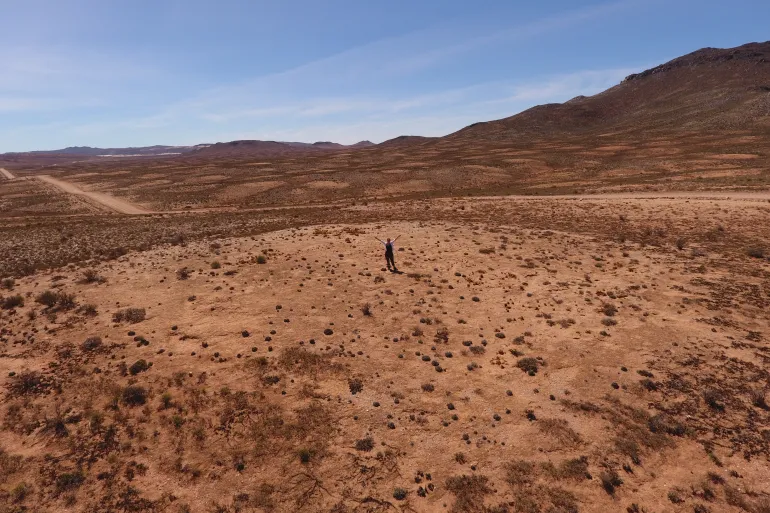
The discovery of a 34,000-year-old mound in South Africa sheds light on the insects’ role in combating climate change
On a cloudless September morning in Buffelsrivier, a desolate corner of Namaqualand some 530km (329 miles) north of Cape Town, Stellenbosch University soil scientists Cathy Clarke and Michele Francis watch as a giant Volvo excavator tears into the dry ochre earth. Over the next five hours the excavator works hard to dig a trench, 60m (197 feet) long and 3m (10 feet) deep, through the heart of a giant, low-slung mound known locally as a heuweltjie or “little hill”. It’s all part of a university project to understand why the groundwater in the area is so salty
Once the digger has returned to the nearby town of Springbok, population 12,790, Clarke, Francis, and a bevvy of grad students begin to explore the trench.
They start at its extremities, what Francis describes as the “boring bits”, feeling the soil and looking for signs of life. As they move inwards, they start to notice small conglomerations of bewildered southern harvester termites (Microhodotermes viator) furiously trying to repair the damage done to their home
This kind of challenge is all in a day’s work for soil scientists, says Clarke, who describes her discipline as “a fun mix of everything from bucket science to high precision X-ray techniques
Once they’d taken some time to simply marvel at the work achieved by these 1cm (0.4 inch)-long creatures, they moved on to the business at hand: taking soil samples. “I delegated the task to a young male student with a pickaxe,” laughs Clarke. “But he couldn’t get the steel blade to penetrate the sides of the trench.”
The ground was so hard, according to John Midgley – an entomologist at the KwaZulu-Natal Museum who was not involved in the project – because it was part of an “ancient mound” created by termites over thousands of years.
Eventually, after lots of huffing and puffing, the grad student was able to obtain a sample the size of a soccer ball, which was sent for testing.
Francis tells me that when they got back to their hotel in Springbok at the end of the day, the cleaner reported them to the manager: “She thought we were zama zamas [South African slang for illegal miners] because our rooms were coated in orange dust,” she says, adding, “I guess she [the cleaner] had a point
How old is old?
The soil scientists knew instinctively that they had dug up a very old termite nest. But neither of them was prepared for quite how old it would be. They submitted samples for radiocarbon dating from the nests and soils from locations across the giant mound. These tests analysed the soil organic carbon (decomposed organic matter dragged into the nests by termites) and the soil mineral calcite (inorganic carbon in the form of calcium carbonate) to give a complete picture of the mound’s age.
While the entomologist Midgley has no doubt that termites have been active in the area for at least 30,000 years (fossilised nests were first found in the area in the 1930s), he says there is no way of proving that the nest has been continually inhabited for all of that time. “There is a high density of nests in the area. Recolonization seems inevitable, if not necessarily intentional,” explains Midgley.
Either way, research by Clarke and Francis shines a light on the role these misunderstood insects play as ecosystem engineers. At least 165 termite species, from 54 genera, are found in southern Africa. Although there are large differences between genera they are all characterised by a high degree of social organisation, with each species containing several distinct “castes”. Depending on their caste – reproductive (king and queen), soldier or worker – termites of the same species can look and behave completely differently.
“”The termites are one of the reasons for the Namaqualand’s incredible biodiversity,” says Clarke. The biome, known officially as the Succulent Karoo, is considered “the world’s most biodiverse desert region“.
But this is not the only way they benefit the planet

An accidental discovery
The heuweltjies formed by southern harvester termites are quite unlike the dramatic pinnacles built by other species in Africa, Australia and South America. But this does not make them any less fascinating. Measuring up to 40 metres (132 feet) in diameter, these raised mounds containing intricate networks of termite tunnels and nests cover up to 27 percent of the surface area of Namaqualand. Scientists are divided over whether the termites actually construct the heuweltjies – but even sceptics admit that the termites play a critical role in their formation.
The southern harvester termite has a broad distribution range, but heuweltjies – which are the result of a buildup of fine soil material, carbon and salts over centuries – only form in semi-desert regions.
The southern harvester termite is also common in and around Stellenbosch (the picturesque Winelands university town, about 50km east of Cape Town, where Clarke is based), but the heavy winter rains and dense vegetation prevent mound formation.
Here the presence of the termites is highlighted by large bush clumps in the scrubby fynbos (native vegetation) and in nutrient-rich patches in vineyards and fruit orchards.
While dating the water, they had to date the sediments around it. This process didn’t just lead to the accidental discovery of some very old termite nests. It also confirmed that the salts and other minerals in the groundwater were the direct result of termite activity. When it rains, Francis explains, “the salts built up in the mounds over thousands of years are flushed into the groundwater system via flow paths created by the tunnelling action of the termites, pushing the dissolved minerals ever deeper

